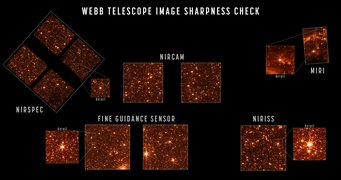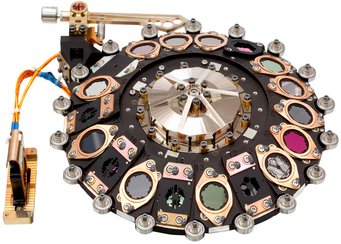JWST publishes first test images of its full suite of instruments
The James Webb Space Telescope (JWST) has published the first set of test images from all of its instruments, demonstrating in an impressive manner that its 6.5 meter mirror, which consists of 18 segments that need to be aligned very precisely, is now fully aligned. The set includes images taken with the MIRI and NIRSPEC instruments, parts of which were constructed at the Max Planck Institute for Astronomy in Heidelberg (MPIA). The completion of mirror alignment marks the beginning of the instrument commissioning phase, where MIRI, NIRSPEC and two additional instruments will become fully operational.


At the core of the observing power of the James Webb Space Telescope, a joint project between NASA, ESA and the Canadian Space Agency CSA, is its enormous mirror, 6.5 meters in diameter. Since there was and still is no way to launch a mirror that size into space in one piece, the JWST mirror is segmented into 18 smaller mirrors, each 1.3 meters in diameter. In order for the segments to act as a single large mirror, they need to be aligned very precisely. Mirror positions need to be as accurate as 50 nanometers, roughly 1/1000 of the diameter of a human hair. That alignment has now been completed successfully – and NASA has published test images from all four of the telescope’s instruments as visual proof.
For MPIA director Thomas Henning and for Oliver Krause, head of MPIA’s Infrared Space Astronomy Group, seeing the images taken with the MIRI mid-infrared instrument and the calibration camera of the spectrograph NIRSPEC is particularly exciting: MPIA is a leading partner in the European collaboration that built the MIRI instrument, and also contributed key parts to NIRSPEC.
Thomas Henning says: „After years of concentrated work on MIRI, we finally have exquisitely sharp images from this and the other instruments, showing us details of the Large Magellanic Clouds. The images conclusively demonstrate the high quality of the telescope’s optics. And in a few months, we will have the first batches of scientific data – observations that, in this form, are only possible with the JWST, which improves the available sensitivity by a factor of more than a thousand. Clearly, there is a completely new view of the infrared universe in store for us.”
Next, the four JWST instruments will be commissioned, that is, put through their paces, calibrated and made fully informational, in time for the start of scientific observations in early summer. For Krause and his group
Background information

